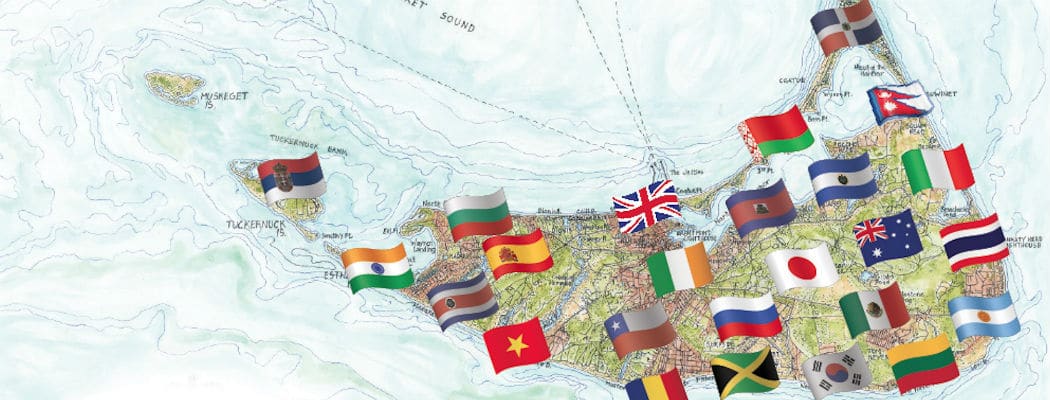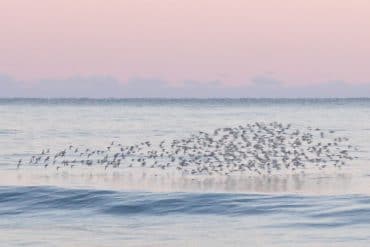Examining the evolving demographics of Nantucket’s year-round population.
 Nantucket is changing before our eyes. It’s a refrain you’ve probably heard before. Sure, there are more cars. Yes, the cottages are being replaced by McMansions and the motorboats by mega-yachts. But perhaps the most profound change is the sweeping demographic shifts that are remaking Nantucket’s year-round population. The island is experiencing an incredible transformation as immigrants from around the world come not only to find seasonal work, but also decide to stay and make Nantucket their permanent home.
Nantucket is changing before our eyes. It’s a refrain you’ve probably heard before. Sure, there are more cars. Yes, the cottages are being replaced by McMansions and the motorboats by mega-yachts. But perhaps the most profound change is the sweeping demographic shifts that are remaking Nantucket’s year-round population. The island is experiencing an incredible transformation as immigrants from around the world come not only to find seasonal work, but also decide to stay and make Nantucket their permanent home.
Island resident Peter Morrison spent more than forty years analyzing population trends as a demographer for the Rand Corporation. When he’s not working shifts for Cape Air at Nantucket Memorial Airport, Morrison tracks the island’s demographic trends with a keen eye. What he’s seeing today is remarkable.
The island, he says, has historically been an immigrant entry port in which pioneering migrants from around the world arrived and eventually established self-perpetuating communities. In the past, it was the Irish and the Cape Verdeans. Today it is immigrants from Eastern Europe, Asia, the Caribbean and, most prominently, Latin America. “The most fascinating aspect of this is the long term transformation that is going to occur,” Morrison says.
Morrison likens Nantucket’s seasonal economy to a conveyor belt that brings thousands of workers from around the world to the island’s shores. Most return home when the season ends. But increasingly, these workers have decided to step off the conveyor belt and make Nantucket their permanent home. These immigrants have found opportunities, started businesses, had babies and managed to establish a foothold on the island despite its high cost of living and extreme lack of affordable housing.
“Nantucket’s going to be a different place if you think in terms of the conventional categories — less white, more people of color,” Morrison says. “But that’s a distinction that’s going to diminish in significance because of the demographic changes themselves. If you come back here in twenty years, the distinctions between people of color and white people are going to feel maybe the same way as distinctions between people of German ancestry and Irish ancestry feel today.”
The US Census Bureau’s official population estimate for Nantucket is 10,925 year-round residents. For those of us actually living on the island, it’s a laughable number. Whether it’s the enrollment at the schools, the massive volume of trash generated at the landfill, or the island’s soaring demand for electricity, Nantucketers know the real year-round population number is far higher.
 At the Nantucket Town & County Building on Broad Street, Town Clerk Catherine Flanagan Stover has made it her mission to find the true number. Through voter registration and tracking additions to the town street list, Stover says she can officially put a name on more than thirteen thousand year-round residents. But if you include all the people who haven’t been counted, many of whom are part of the surge of immigrants to arrive on the island since the last official Census Bureau count in 2010, Stover believes Nantucket’s year-round population may actually be more than 23,000 souls.
At the Nantucket Town & County Building on Broad Street, Town Clerk Catherine Flanagan Stover has made it her mission to find the true number. Through voter registration and tracking additions to the town street list, Stover says she can officially put a name on more than thirteen thousand year-round residents. But if you include all the people who haven’t been counted, many of whom are part of the surge of immigrants to arrive on the island since the last official Census Bureau count in 2010, Stover believes Nantucket’s year-round population may actually be more than 23,000 souls.
“In the last five years, it’s gone right through the roof,” she says. On a recent fall day inside her office, Stover went into the vault to retrieve a book that contains the birth certificates of every baby born on Nantucket. As she flipped through the records, she pointed out the parents’ country of origin listed on each of the certificates. “China, Jamaica, El Salvador, Lithuania, Sierra Leone, Trinidad, Belarus, the Dominican Republic,” she says. Pointing to one of the birth certificates that caught her eye she adds, “There’s two American parents — that’s almost unheard of now.” According to those birth certificate records, 63 percent of the babies born on Nantucket in 2015 had at least one foreign-born parent. Last year, the number of newborns on the island with two foreign-born parents actually outnumbered those babies with two American parents.
At Nantucket Cottage Hospital, which tracks births by fiscal year, (Oct. 1–Sept. 30), there were 159 babies born at the hospital during the most recent year, the most ever for a one-year period on record. As if to drive home the point, Stover mentioned her own grandson, whose father is Dominican and who lives in a household in which three languages are spoken: Portuguese, Spanish, and English. When she’s not serving as Nantucket’s Town Clerk, Stover is also a justice of the peace and officiates her fair share of weddings on the island.
“I do a Salvadoran wedding every week,” she says, showing off a printed copy of her prepared script for a wedding ceremony that had been translated into Spanish. “Sometimes two or three.” Beyond the significant populations of Salvadorans, Jamaicans, and Eastern Europeans on the island, Nantucket also has blossoming immigrant communities from Nepal and Thailand.
While Nantucket has welcomed immigrants and new cultures in the past, the scale of the demographic shifts in recent years is unprecedented. “It’s an unfolding wave,” Morrison said. Nowhere is that wave more apparent than in the Nantucket Public School system. As recently as the late 1990s, the island school district was 97 percent white. Twenty years later, more than 40 percent of the student body is non-white, including large concentrations of Hispanic, Jamaican, Asian and Eastern European students. That includes over 370 bilingual children, with eleven different home languages represented in the district.
“That’s an enormous shift if you think about that — 40 percent of the student population in twenty years,” says Jeremiah Splaine, the director of English language learner (ELL) services at the Nantucket Public Schools. “But that does absolutely mirror the growth of the immigrant community on the island because we get all the kids. We see the demographics starkly here, more so than you would in probably any other setting in the community.”
 The number of ELL students enrolled in Nantucket’s public schools has more than doubled over the past four years, with 255 children currently receiving ELL services during the 2016–2017 school year. As a percentage of total enrollment, 16 percent of all island students receive ELL services, compared to the statewide aver- age of 9 percent for all public schools in Massachusetts. More than job sites or the Stop & Shop, the island’s public schools have become the one place where Nantucket’s melting pot of cultures truly come together and interact under one roof.
The number of ELL students enrolled in Nantucket’s public schools has more than doubled over the past four years, with 255 children currently receiving ELL services during the 2016–2017 school year. As a percentage of total enrollment, 16 percent of all island students receive ELL services, compared to the statewide aver- age of 9 percent for all public schools in Massachusetts. More than job sites or the Stop & Shop, the island’s public schools have become the one place where Nantucket’s melting pot of cultures truly come together and interact under one roof.
“Once the students are within the four walls here, kids are kids. They gravitate toward each other and the language barrier doesn’t prohibit that,” Splaine says. “We have a truly multinational soccer team with kids from Ireland, Bulgaria, Brazil, Honduras, Mexico and Jamaica. The kids just naturally work it out.” For a relatively small school district, the effects of this influx are significant — both socially and fiscally. In 2003, the Nantucket Public Schools had one full-time teacher devoted to ELL services. Today, Splaine oversees a formal ELL department that includes nine full-time teachers. “It sort of mushroomed, and it seemed like overnight,” Splaine says.
The overall enrollment in the district has soared from one thousand students in 1993 to 1,588 during the current school year, a 59 percent increase during that span. The Nantucket Elementary School is becoming one of the largest public elementary schools in Massachusetts. This growth prompted school officials to propose a $46 million tax override to fund the construction of a new intermediate school for grades three through five, and an expansion of the Cyrus Peirce Middle School, which sailed through Nantucket’s Annual Town Meeting in April, 2015 and was later approved at the ballot. The numbers are staggering, but they reveal just one aspect of Nantucket’s demographic changes. The personal stories from the people themselves paint a fuller picture of what’s happening on the island.
The Noé Pineda Story
On Jan. 7, 2016, Noé Pineda found himself on the front page of Nantucket’s Inquirer and Mirror newspaper. Twenty-three years after fleeing the bloodshed of El Salvador’s civil war, and after surviving the journey north across Central America to the US–Mexican border, Pineda smiled in the photo like only a proud father could. He was holding his newborn baby daughter, Maria Raquel, who was the island’s “New Year’s Baby” for 2016, along with his wife Sonia Raquel.
For a man who only attained a fourth-grade education back in El Salvador and entered the United States penniless and unable to speak a word of English, Pineda had come a long way. The unlikelihood of his smiling face gracing the front page of Nantucket’s newspaper was not lost on him. Now, he says, “I want to see how far I can go.”
 And why wouldn’t he? Since leaving El Salvador, Pineda has become bilingual, a homeowner and is a fourteen-year veteran on the maintenance crew at Nantucket Memorial Airport where he earns nearly $60,000 per year. Pineda is one of the thousands of Salvadorans who have made their way to Nantucket since the late 1990s, a group that today represents by far the largest immigrant population on the island. There’s no official count, of course, but both Pineda and Stover, the Town Clerk, estimate Nantucket’s Salvadoran population at 5,000 to 6,000 people. A significant number of those Salvadorans, Pineda included, hail from Agua Caliente, the small rural town in the Central American country that is now inexorably linked to Nantucket.
And why wouldn’t he? Since leaving El Salvador, Pineda has become bilingual, a homeowner and is a fourteen-year veteran on the maintenance crew at Nantucket Memorial Airport where he earns nearly $60,000 per year. Pineda is one of the thousands of Salvadorans who have made their way to Nantucket since the late 1990s, a group that today represents by far the largest immigrant population on the island. There’s no official count, of course, but both Pineda and Stover, the Town Clerk, estimate Nantucket’s Salvadoran population at 5,000 to 6,000 people. A significant number of those Salvadorans, Pineda included, hail from Agua Caliente, the small rural town in the Central American country that is now inexorably linked to Nantucket.
Some of the first Salvadorans to settle on Nantucket were from Agua Caliente and came to the island via Boston in the late 1990s as opportunities in the island’s seasonal economy beckoned. Among them were members of the Tejada family, who were recruited to work on Nantucket by the late Jack McFarland, the former facilities manager for the island’s public schools.
The Tejadas, like Pineda, escaped from Agua Caliente as the brutal conflict between leftist guerillas and the U.S.-backed Salvadoran government escalated. Pineda’s memories of that time are painful. He recalled a day working in the fields when he and his brothers were caught in the middle of a firefight. He thought one of his brothers had been killed before finding him at their home hours later, frightened but unhurt.
“It was tough,” he recalled while sitting in the small break room at Nantucket Memorial Airport. “You cannot even imagine unless you’ re able to experience it. Our country has struggled so bad. We’re so small and don’t have a good economy. The whole country was devastated.”
In 1993, just after the civil war climaxed and came to an end, Pineda decided it was time to leave. A friend who was already in the United States offered to pay half of the $8,000 he needed for the journey north. And so with eighteen other Salvadorans, Pineda travelled by car through Guatemala and Mexico before reaching the border. Not everyone he was with made it through that final leg across the desert into the United States, he says. “Some people get kidnapped or robbed,” Pineda recalls. “I don’t know what happened to them.” But he did make it across the border and ended up in San Diego, California where his friend put down the money for a flight to Boston.
With others from Agua Caliente, Pineda settled into a new life in a foreign land. He bought a set of cassette tapes to learn English. He managed to find work cleaning retail stores in Boston. And he applied for political asylum, allowing him to obtain a work permit.
Pineda arrived on Nantucket in the spring of 1999 at the invitation of a friend from church in Boston. He began working as a custodian at the public schools and at the Nantucket Golf Club, where he lived in the club’s dormitory. He quickly set out to establish a church group for Spanish-speaking residents of the island. Today that small group has blossomed into a full congregation. The Sunday Mass in Spanish at St. Mary’s Church on Federal Street is regularly attended by more than two hundred people. It is a reflection, Pineda says, of the thousands of Salvadorans, Dominicans, Mexicans and other Latinos who now call Nantucket home. These extended families, friends and acquaintances have learned how to live together on Nantucket despite the sky-high rents and cost of living. That often means pooling resources, with multiple families living together under one roof. “It hasn’t been easy. It’s been tough,” Pineda says. “You can’t have a room to yourself. You have to share with people. That’s how we’ve been surviving.”
The Martin Anguelov Story
For some of Nantucket’s other immigrants, the journey to the island may not have been as harrowing, but it was no less unlikely. Growing up in communist Bulgaria when it was part of the Soviet-led Eastern Bloc, Martin Anguelov never thought he would leave his home country. But when he was fifteen, the communist regime fell, the borders opened up, and Anguelov’s path in life would soon lead him to Nantucket.
Through a student exchange program, Anguelov came to the United States in 1997 on a J1 visa and took a job as a dishwasher and prep cook at Hutch’s, the former restaurant at the Nantucket Memorial Airport terminal. At night, he took a second job at Island Pharmacy. Fast forward nearly twenty years, and Anguelov is now the finance director for the Nantucket Public Schools. He has two children who were born at Nantucket Cottage Hos pital. And he is one of hundreds, if not thousands, of Bulgarians who now call Nantucket home.
 “I’ve been lucky,” Anguelov said. “The community here, I can’t say enough. The community of this island has been great to me and my family. We love the island, and I do consider myself lucky to have met the people I have along the way.” After making the decision to stay on Nantucket year-round in the late 1990s, Anguelov worked his way up at Island Pharmacy from a sales clerk position to manager. He met his wife, who is also from Bulgaria, while working at the pharmacy. Meanwhile, Anguelov pursued higher education and not only received a Masters degree in business administration from Babson College in 2006, but also went on to become a certified public accountant.
“I’ve been lucky,” Anguelov said. “The community here, I can’t say enough. The community of this island has been great to me and my family. We love the island, and I do consider myself lucky to have met the people I have along the way.” After making the decision to stay on Nantucket year-round in the late 1990s, Anguelov worked his way up at Island Pharmacy from a sales clerk position to manager. He met his wife, who is also from Bulgaria, while working at the pharmacy. Meanwhile, Anguelov pursued higher education and not only received a Masters degree in business administration from Babson College in 2006, but also went on to become a certified public accountant.
In 2013, after an extensive process, Anguelov became an American citizen during a ceremony at the JFK Library in Boston.
The Bulgarian community on Nantucket, Anguelov says, is full of success stories like his, including friends and acquaintances who are now electricians, web designers and small business owners. The island’s Bulgarians have been able to integrate into the island community while still retaining their cultural identity, he says. On Saturdays at the Congregational Church on Centre Street, for instance, there is a Bulgarian school where the children of immigrants who were born on Nantucket learn to speak and write Bulgarian.
“It’s a great way of keeping up not just with the language and writing, but also the traditions and culture,” Anguelov says. Bulgarians are the largest of several Eastern European groups that are establishing themselves on Nantucket, including those from Belarus, Lithuania, Romania and Russia.
The Ochand Lee Story
At the Hyline dock on Straight Wharf, one of the most familiar faces who greets and bids farewell to visitors and residents doesn’t hail from Nantucket. Ochand Lee – perhaps better known by his social media moniker “Chad Pierre” – is a transplant from Jamaica who now lives year-round on the island. Unlike some other immigrants who found their way to Nantucket by word of mouth or family connections, it was actually Nantucket that came to Lee.
Sixteen years ago, Nantucket Island Resorts was recruiting hospitality workers from Jamaica. Lee, who had a background and education in hotel and restaurant management, interviewed with the company and secured an H2B visa that allowed him to work seasonally as a front desk agent at the Harbor House Village. He came back for another season on the island, and then another. By 2004, he was living here year-round, and was eventually joined by his mother, Angela Hinds, a housekeeper at The Beachside, and his sister Emmalesa Hall, who works at Stop & Shop.
The seasonal work program that brought Lee to Nantucket has been attracting Jamaicans to the island for decades. More and more, however, these Jamaicans decide to stay on their adopted island. “A big portion of them were seasonal, but now there’s a huge number of year-round residents,” Lee said of Nantucket’s Jamaican population. “People should understand that when they come to Nantucket, almost every establishment has Jamaicans working there – front of the house, back of the house, housekeeping, front desk, management positions, chefs, waiters – you name any position, Jamaicans are good at that.”
Like other cultures on the island, the Jamaican community has established a church on Nantucket – New Life Ministries – that meets under a tent on property at Monohansett Road, and inside the Methodist Church on Centre Street during the summertime. “We want people to know that Jamaicans are warm and friendly and welcoming people – we bring that spirit everywhere we go,” Lee said.
When he’s not working at the Hyline terminal, Lee has carved out a second niche for himself as a photographer. Over the summer, his images of celebrities enjoying Nantucket, including New England Patriots wide receiver Julian Edelman with supermodel Adriana Lima, as well as Kourtney Kardashian, were picked up by TMZ, the Boston Herald and other outlets. Lee, like Anguelov and Pineda, has seized the opportunities that Nantucket has offered, and demonstrate why so many continue to exit the seasonal conveyor belt that Morrison described.
Lee, Anguelov and Pineda have seized the opportunities that Nantucket has offered and demonstrate why so many continue to exit the seasonal conveyor belt that Morrison describes. “Nantucket is going to be the scene of numerous personal success stories on the part of immigrants who have come here,” Morrison says. “There’s going to be a lot of people who come here from humble origins who are going to look back and say, ‘Boy, I came here without a penny in my pocket and look where I am now.’”






